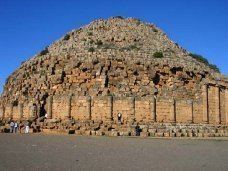42 AD–7th century → | Today part of Algeria | |
 | ||
Mauritania Caesariensis (Latin for "Caesarian"Mauretania") was a Roman province located in what is now Algeria in the Maghreb. The full name refers to its capital Caesarea (Mauritaniae) (modern Cherchell) in order to distinguish it from neighboring Mauretania Tingitana, which was ruled from Tingis (now Tangiers in Morocco).
Contents
Roman History
In the 1st century AD, Roman emperor Claudius divided the westernmost Roman province in Africa, named Mauretania (land of the Mauri people, hence the word Moors), into Mauretania Caesariensis (named after its capital, one of many cities simply named Caesarea after the imperial cognomen that had become a title) and Mauretania Tingitana.
Mauretania Caesariensis contained eight colonies founded by the Emperor Augustus: Cartennas, Gunugu, Igilgili, Rusguniae, Rusazu, Saldae, Zuccabar, Tubusuctu; two by the Emperor Claudius: Caesarea formerly "Iol" the capital of Juba, who gave it this name in honour of his patron Augustus, and Oppidum Novum; one by the Emperor Nerva: Setifis; and in later times, Arsenaria, Bida, Siga, Aquae Calidae, Quiza Xenitana, Rusucurru, Auzia, Gilva, Icosium and Tipasa in all 21 well-known colonies, besides several “municipia” and “oppida Latina.”
Under Diocletian's Tetrarchy reform, the easternmost part was broken off from Mauretania Caesariensis as a separate small province, Mauretania Sitifensis, called after its inland capital Sitifis (actual Sétif) with a significant port at Saldae (presently Béjaïa).
At the time of Diocletian and Constantine the Great, both Sitifensis and Caesariensis were assigned to the administrative Diocese of Africa, in the praetorian prefecture of Italy, while Tingitana was an outpost of the Diocese of Spain.
Religion and later history
Caesarea was a major center of Judaism before 330, and Sitifis was one of the centres of the soldier cult of Mithraic mysteries. Christianity spread throughout in the 4th and 5th centuries.
Among the ruling class, Trinitarian Christianity was replaced by Arianism under the Germanic kingdom of the Vandals, which was established in 430, when the Vandals crossed the Strait of Gibraltar.
The Vandal kingdom in Africa was extinguished by Byzantine armies around 533, but most of Mauretania Caesariensis remained under the control of local Moorish rulers such as Mastigas, and it was not until the 560s and 570s that Byzantine control was established in the interior.
The Muslim conquest of the Maghreb for the caliphate under the Umayyad dynasty meant the end of the Byzantine Exarchate of Africa and Late Antique Roman culture there; most of former Mauretania Caesariensis became part of the westernmost Islamic province, henceforth called the Maghreb (meaning 'West'ern part of the Arab world). Bishoprics were wiped out by Islam, while many town faded, being swallowed by the advancing Sahara.
Episcopal sees
Ancient episcopal sees of Mauretania Caesariensis listed in the Annuario Pontificio as titular sees:
Economy
The principal exports from Caesariensis were purple dyes and valuable woods; and the Amazigh or Mauri were highly regarded by the Romans as soldiers, especially light cavalry. They produced one of Trajan's best generals, Lusius Quietus, and the emperor Macrinus.
